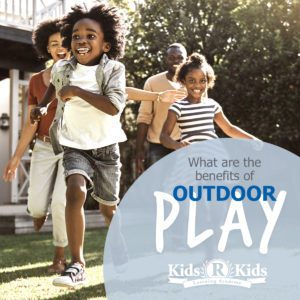 1. It invites children to learn science
1. It invites children to learn science
Children are natural explorers and discoverers, and you can bring whatever interests them back for further exploration. An acorn won’t grow quickly enough to satisfy a curious child — it takes two months for the first shoots to appear! But there are faster-growing seeds (peas, green beans, corn) perfect for experiments. Picture books, like The Carrot Seed by Ruth Krauss and Growing Vegetable Soup by Lois Ehlert, add early literacy to the mix while building children’s vocabulary and knowledge.
2. It creates opportunities for social interaction and collaboration
One-on-one interactions help build a foundation for future relationships that will occur when children enter school. Outdoor play also provides a chance to practice social and emotional skills with other children, including problem-solving, turn-taking, encouragement, self-control, safe risk taking, and following the rules of a game. And outdoor play provides opportunities to develop empathy; for example, imagine one child encouraging another to try the slide or a child comforting another who has fallen down while running.
3. It promotes physical health
The obesity rate for US children ages 2 to 5 is 14 percent, and it rises to over 40 percent for middle-aged adults, leading to an increased risk of health problems like diabetes and heart disease. That’s one reason why the American Academy of Pediatrics recommends a “prescription for play” at every well-child visit through age 2 and Nemours Health and Prevention Services recommends daily, supervised outdoor time for children from birth to age 5. Specifically, Nemours calls for toddlers to have at least 30 minutes of structured (adult-led) physical activity and at least 60 minutes of unstructured (child-led) physical activity each day. Outdoor play is a great way to model the joy of physical activity. When children run, jump, climb, throw and kick balls, and ride toys that require balance, they also build gross motor skills and start developing a habit of being active.
4. It invites new contexts for learning
You can use outdoor spaces to create intentional learning activities that are difficult to execute inside. There’s great value in looking at books about nature in the shade of a tree, pouring (and splashing!) water at an outdoor water table, building extra-large structures in the sandbox or mud, collecting leaves, watching a parade of ants, and playing pretend on a playground structure. To make the most of your outdoor time, think about creative, joyful, engaging activities that capitalize on children’s need to move and enthusiasm for doing so, while also achieving other curricular goals. For example, you might create a sorting game in which your child has to find all the yellow balls and all the red balls hidden in the yard, then sort them into two groups.
5. It promotes better sleep
A study of 2- to 5-year-olds showed that children who play outdoors sleep better at night (Deziel 2017). This may be due to the physical activity, stress reduction, and exposure to natural light that come with playing outdoors (Coyle 2011). A tired, happy child is one who sleeps well!
6. It gives children a chance to take appropriate risks
Toddlers are all about challenging themselves to do new and difficult things—pet a dog, climb some stairs, venture a little farther away from a caregiver and then return. Playing outside provides opportunities to run faster, climb higher, jump farther, and more — all under the watchful eye of a caring adult.
7. It may lead to better learning outcomes once children return to other activities
Research shows that older children are more attentive and productive in the classroom when recess — indoors or outdoors — is part of the school day (Council on School Health 2013). If older children need a brain break, it follows that younger ones do too.
8. It supports STEM skills
Remember making mud pies and forts when you were a child? The outdoors is the perfect place for big (and messy) projects that support STEM (science, technology, engineering, and mathematics) skills, such as building, sand and water play, and investigations of the natural world. Almost any indoor activity can be brought outside for further exploration.
9. It anchors children to the real world
Talking with a child about an illustration of a bird in a picture book is good, but sharing the book and the experience in the real world is even better: “I wonder what that robin is looking for in the grass? Oh, look! It got a worm!” Children develop more comprehensive knowledge about their world when they have a chance to watch, observe, predict, and learn in the moment.
Conclusion
Playing outdoors has benefits for young children. It’s a refreshing pause in the day’s schedule — time set aside to look and listen, explore and observe, move and let loose. Time spent outside can lead to better physical and mental health, improved sleep, and cognitive, social, and emotional gains for young children. Ensuring that outdoor play is an integral part of your child’s daily schedule supports early learning across all domains and unleashes a whole lot of joy — for you and for your child!
by Kathy Kisner